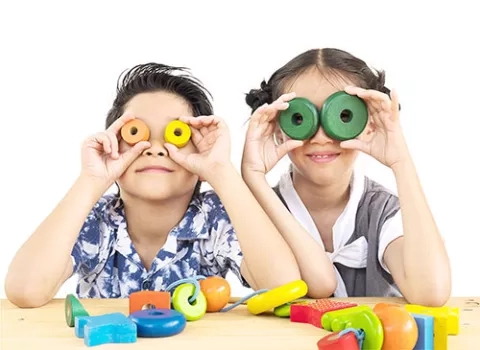

EyeScreen
Safeguarding your child's windows to the world
Importance of Paediatric Vision Screening

Why should I have my infant / toddler’s eyesight checked?
Singapore is known as the myopia capital of the world. According to the latest Singapore Health Promotion Board (HPB) figures from 2011, about 16% of preschool children are short-sighted, a 7% increase from 20091. Frequent use of digital devices, such as smartphones and iPads, in young children may only serve to accelerate this trend.
Other eye problems such as Strabismus (Crossed Eyes), Amblyopia (Lazy Eye) can usually go unnoticed until your child starts schooling. If lazy eye is only detected after the age of 8, it may not be possible to reverse the eye damage2 . Early detection of lazy eye is important because treatment tends to be more effective the younger the child is, especially before the age of four3.
Untreated Strabismus and Amblyopia may lead to permanent visual impairment, and could pose as stumbling blocks to jobs that require good vision in both eyes, such as a pilot and certain doctor specialties, like ophthalmology. Any undetected and uncorrected vision problems in your child could also result in reading and learning difficulties4.
3 reasons to get your child’s vision screened
Early detection
The purpose of paediatric vision screening is to allow for the early detection of vision problems in children as young as 6 months old. Common paediatric vision problems include conditions such as strabismus, amblyopia, myopia, astigmatism, hyperopia and other lesser known conditions including cataracts, and ptosis.
Early intervention
The earlier an eye problem is detected, the earlier the appropriate treatment could be recommended for your child to prevent permanent visual impairment. In the event of a positive detection, intervention, including prescription for glasses, patch therapy, medication or even surgery may be prescribed by the ophthalmologist to restore your child’s vision.
Timely vision screening
The American Optometric Association (AOA) recommends a child to have his/her first vision screening between the age of 6 and 12 months even if no eye problem is apparent5.
The American Academy of Paediatrics (AAOP) recommends timely vision screening in infancy and childhood for early detection and treatment6.
What do we screen for?
References
1) Aoa.org. Accessed on 11 June 2015. http://www.aoa.org/patients-and-public/eye-and-vision-problems/glossary-of-eye-and-vision-conditions/hyperopia
2) Aapos.org. Accessed on 11 June 2015. http://www.aapos.org/client_data/files/2014/337_visionscreeningforinfantsandchildren_2013.pdf
3) Aapos.org. Accessed on 11 June 2015. http://www.aapos.org/terms/conditions/91
4) Allaboutvision.com. Accessed on 11 June 2015. http://www.allaboutvision.com/conditions/colordeficiency.htm
5) Colour Blind awarenesss. Accessed on 11 June 2015 http://www.colourblindawareness.org/colour-blindness/
How do we screen?
Eyescreen™ is a speedy, safe and non-invasive screening that does not require any physical contact with your child or eyedrops to dilate the pupils. By following steps 1-2-3-4, Eyescreen™ is able to detect eye problems and hence, allowing effective treatment to be administered as early as possible.
Step 1
Assess

Your child's vision development will be assessed.
Step 2
Screen

Your child will be photo-screened by our paediatric optometrist.
Step 3
Further tests

Your child will be routed for supplementary testing (optional) if he or she is older.
Step 4
Result

You will receive screening report on the spot after screening.
